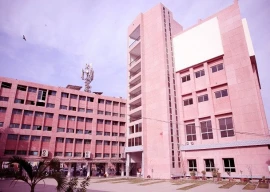
The water level at the Taunsa Barrage has fallen to 0.614 million cusecs, which is 0.1 million cusecs over the usual levels of River Indus. At Kalabagh, the reading was 0.474 million cusecs. However, the water level at the Chashma Barrage was recorded at 0.575 million cusecs and the situation is alarming as the level has not decreased. According to irrigation sources, the level should be less than 0.5 million cusecs but it hasn’t gone down because water from both Khyber-Pakhtunkhwa’s rivers and River Jhelum is accumulating at this point.
Repatriation has also begun in Punjab. Those displaced from Daira Deen Panah, where a dyke had burst and floods had caused massive devastation, returned on Monday. As many as 0.5 million have gone back to the area and an equal number of people have returned to Muzzaffargarh and Kot Addu. The Kot Addu Power Company’s (Kapco) plant has resumed production, which will reduce the daily electricity shortfall in Pakistan by 1,200 MW.
However, all is not normal in the province. Water is now flowing near the town of Khangarh and to secure the area, the flood is being drained into the Chenab River where water level is at 0.31 million cusecs. In Dera Ghazi Khan district, the Punjab government has sent just 4,000 tents for the 150,000 displaced people.
The National Highway, which is known as KLP and connects Punjab and Sindh, is closed for traffic from Rahim Yar Khan, one of the worst-hit and most threatened districts. The Rainy Canal, also known as the Thar Canal, has overflowed and flooded seven to eight villages, displaced 140,000 people and devastating 200,000 acres of agricultural land.
In Rajanpur, the Qadra Canal has developed cracks at three points. This dyke is also known as the defence head, and if it bursts, the entire area of Rajanpur will be flooded. Due to the cracks, Head Gopang is under immense pressure and the administration has imposed Section 144 in the area as they try to repair the canal.
At the same time, malaria and gastroenteritis have affected as many as 6,000 to 8,000 people in the flood-hit districts. (With reporting by Owais Jaffery in Multan)
Published in The Express Tribune, August 07th, 2010.









1726722687-0/Express-Tribune-Web-(9)1726722687-0-270x192.webp)







COMMENTS (1)
Comments are moderated and generally will be posted if they are on-topic and not abusive.
For more information, please see our Comments FAQ